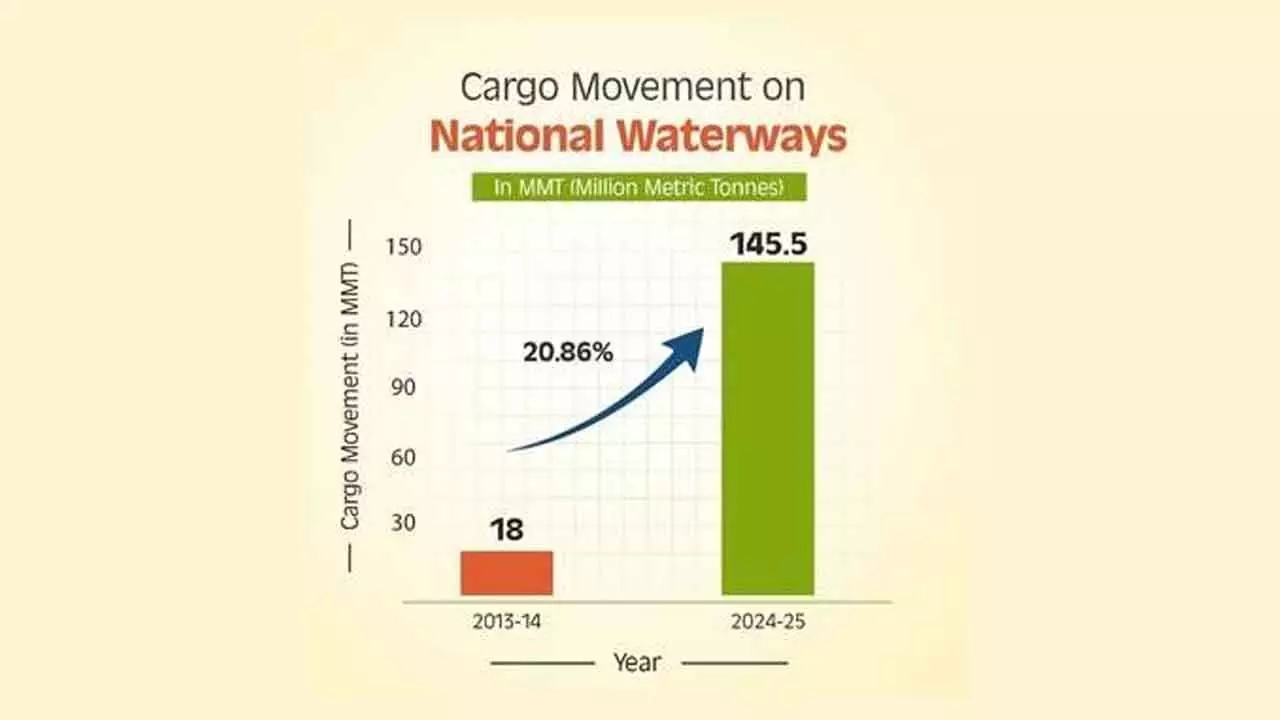Cargo Movement On Inland Waterways Hits A Record 145.5 Mmt In FY25
Passenger movement also reached an impressive 1.61 crore in 2023–24
Cargo Movement On Inland Waterways Hits A Record 145.5 Mmt In FY25

India achieved a record 145.5 million tonnes cargo movement on inland waterways in FY 2024–25, up from 18.1 MMT in FY 2013–14, at a CAGR of 20.86 per cent.
The number of National Waterways increased from five to 111, with the operational length growing from 2,716 km (2014–15) to 4,894 km (2023–24).
Massive infrastructure development including Multi-Modal Terminals (MMTs), Inter-Modal Terminals (IMTs), community jetties, floating terminals, and green tech like hybrid electric and hydrogen vessels.
The launch of Jalvahak Scheme with Rs 95.42 crore budget offering 35 per cent operating cost incentive for cargo owners and scheduled services on key routes (NW-1, NW-2, NW-16) was a major forward step.
India aims to increase IWT modal share from two per cent to five per cent and raise traffic to 200+ MMT by 2030 and 500+ MMT by 2047 under Maritime Amrit Kaal Vision.
According to the Inland Waterways Authority of India (IWAI), the record-breaking cargo movement of 145.5 million tonnes in the fiscal year 2024–25 underscores the effectiveness of sustained investments and policy initiatives aimed at enhancing the country's inland waterways infrastructure. The number of operational national waterways has also increased from 24 to 29 during the same period, reflecting a strategic push towards multimodal connectivity and sustainable transport solutions.
Exponential growth in cargo traffic:
In what has been a major push, the cargo traffic on National Waterways increased from 18.10 (million metric tonnes) MMT to 145.5 MMT between FY-14 and FY-25, recording a CAGR of 20.86 per cent.
In FY-25, traffic movement registered a growth of 9.34% year-on-year from FY-24. Five commodities-coal, iron ore, iron ore fines, sand and fly ash- constituted over 68 per cent of total cargo moved on NWs during the year. Passenger movement has also reached 1.61 crore in 2023–24.
Expansion of national waterways:
The Inland Waterways Authority of India (IWAI) expanded the number of National Waterways (NWs) from 5 to 111 under the National Waterways Act, 2016. Since 2014, the government has invested around Rs 6,434 crore to develop waterway infrastructure.
The operational length of NWs increased from 2,716 km (2014-15) to 4,894 km (2023-24). Major works include fairway maintenance, community jetties, floating terminals, Multi-Modal Terminals (MMTs), Inter-Modal Terminals (IMTs), and navigational locks.
To boost Ease of Doing Business, IWAI launched digital tools like Least Available Depth Information System (LADIS), River Information System (RIS), Car-D, Portal for Navigational Information (PANI), and Management Information and Reporting Solution (MIRS). Green initiatives such as hybrid electric catamarans and hydrogen vessels are being introduced to reduce pollution and promote river tourism.
Targets and sustainable development:
The Centre has set ambitious targets for cargo movement via inland waterways. IWAI aims to increase the modal share of freight movement through IWT from two to five and traffic volume to more than 200 MMT in line with the Maritime India Vision 2030 and more than 500 MMT by 2047 as per the Maritime Amrit Kaal Vision 2047.
Policy measures to boost inland waterways:
The Jalvahak – Cargo Promotion Scheme is part of a new initiative that the IWT sector is developing and it needs support to shift cargo from road and rail to waterways. Although waterway transport is cheaper, overall logistics costs can be higher due to multimodal handling.
Towards this, the “Jalvahak” scheme was launched on December 15, 2024 with a budget of Rs. 95.42 crores. It has two key components:
Financial incentive: Cargo owners get a 35 per cent reimbursement on actual operating costs for shifting cargo from road/rail to IWT as a means to encourage use of waterways.
Scheduled services: Regular cargo services have been introduced to boost reliability and predictability.
The key routes include: Kolkata–Patna–Varanasi (NW-1); Kolkata–Pandu (NW-2 via Indo-Bangladesh Protocol route) and Kolkata–Badarpur/Karimganj (NW-16 via IBP route).
Extension of tonnage tax to inland vessels was announced on February 1 this year. The tonnage tax regime has been extended to inland vessels registered under the Indian Vessels Act, 2021.
The biggest benefit is that it provides a stable and predictable tax regime based on vessel tonnage rather than profits, thereby lowering the tax burden and encouraging broader adoption of inland shipping.
In a new measure, a regulatory framework for private investment took shape with the
National Waterways (Construction of Jetties/Terminals) Regulations-2025. It enables private investment in inland waterways infrastructure by establishing a clear legal and operational framework for the construction and management of jetties and terminals.
In order to ensure seamless multimodal logistics, the Multi-Modal Terminals at Varanasi, Sahibganj, and Haldia, as well as the Intermodal Terminal at Kalughat, are being transferred to Shyama Prasad Mookerjee Port, Kolkata, for operation and management. This integration is expected to streamline cargo movement between ports and inland waterways.
With focus on digitisation and centralised database, a centralised portal is being developed for registration of inland vessels and crew, similar to the 'Vahan' and 'Sarathi' systems used for road transport.
This initiative will simplify registration processes, provide real-time data on vessel and crew availability and thereby enhance transparency.
To resolve issues related to sparse industrial presence along waterways, cargo aggregation hubs are under development: They include a freight village at Varanasi and an integrated cluster-cum-logistics park at Sahibganj.

